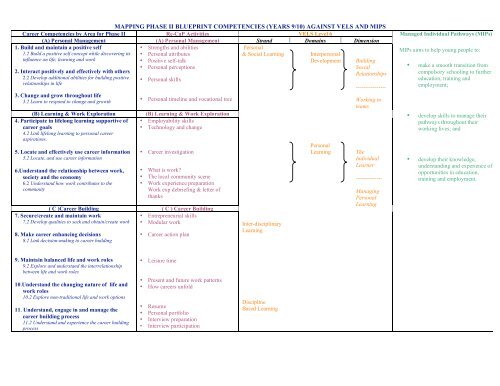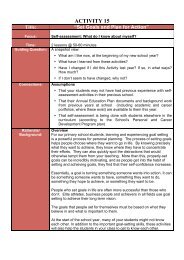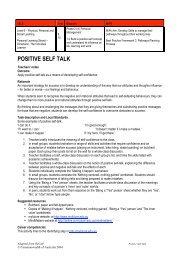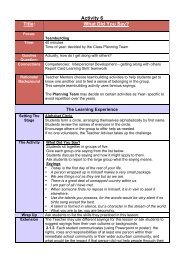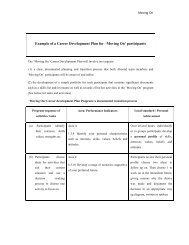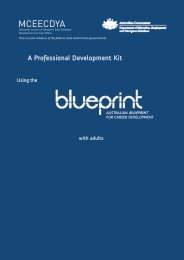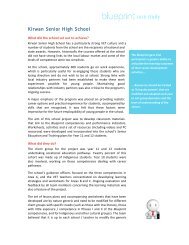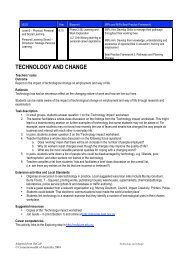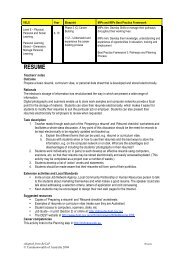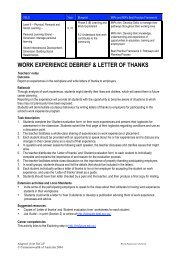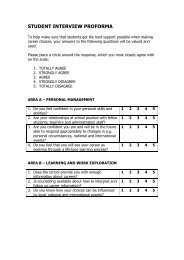Download - Blueprint - Australian Blueprint for Career Development
Download - Blueprint - Australian Blueprint for Career Development
Download - Blueprint - Australian Blueprint for Career Development
Create successful ePaper yourself
Turn your PDF publications into a flip-book with our unique Google optimized e-Paper software.
MAPPING PHASE II BLUEPRINT COMPETENCIES (YEARS 9/10) AGAINST VELS AND MIPS<br />
<strong>Career</strong> Competencies by Area <strong>for</strong> Phase II Re-CaP Activities VELS Level 6<br />
(A) Personal Management (A) Personal Management Strand Domains Dimension<br />
1. Build and maintain a positive self<br />
1.2 Build a positive self concept while discovering its<br />
influence on life, learning and work<br />
2. Interact positively and effectively with others<br />
2.2 Develop additional abilities <strong>for</strong> building positive<br />
relationships in life<br />
3. Change and grow throughout life<br />
3.2 Learn to respond to change and growth<br />
(B) Learning & Work Exploration<br />
4. Participate in lifelong learning supportive of<br />
career goals<br />
4.2 Link lifelong learning to personal career<br />
aspirations.<br />
5. Locate and effectively use career in<strong>for</strong>mation<br />
5.2 Locate, and use career in<strong>for</strong>mation<br />
• Strengths and abilities<br />
• Personal attributes<br />
• Positive self-talk<br />
• Personal perceptions<br />
• Personal skills<br />
• Personal timeline and vocational tree<br />
(B) Learning & Work Exploration<br />
• Employability skills<br />
• Technology and change<br />
• <strong>Career</strong> investigation<br />
6.Understand the relationship between work,<br />
society and the economy<br />
6.2 Understand how work contributes to the<br />
• What is work<br />
• The local community scene<br />
• Work experience preparation<br />
community<br />
• Work exp debriefing & letter of<br />
thanks<br />
( C )<strong>Career</strong> Building ( C ) <strong>Career</strong> Building<br />
7. Secure/create and maintain work<br />
• Entrepreneurial skills<br />
7.2 Develop qualities to seek and obtain/create work • Modular work<br />
8. Make career enhancing decisions<br />
8.2 Link decision-making to career building<br />
• <strong>Career</strong> action plan<br />
Personal<br />
& Social Learning<br />
Inter-disciplinary<br />
Learning<br />
Interpersonal<br />
<strong>Development</strong><br />
Personal<br />
Learning<br />
Building<br />
Social<br />
Relationships<br />
----------------<br />
Working in<br />
teams<br />
The<br />
Individual<br />
Learner<br />
--------------<br />
Managing<br />
Personal<br />
Learning<br />
Managed Individual Pathways (MIPs)<br />
MIPs aims to help young people to:<br />
• make a smooth transition from<br />
compulsory schooling to further<br />
education, training and<br />
employment;<br />
• develop skills to manage their<br />
pathways throughout their<br />
working lives; and<br />
• develop their knowledge,<br />
understanding and experience of<br />
opportunities in education,<br />
training and employment.<br />
9. Maintain balanced life and work roles<br />
9.2 Explore and understand the interrelationship<br />
between life and work roles<br />
10.Understand the changing nature of life and<br />
work roles<br />
10.2 Explore non-traditional life and work options<br />
11. Understand, engage in and manage the<br />
career building process<br />
11.2 Understand and experience the career building<br />
process<br />
• Leisure time<br />
• Present and future work patterns<br />
• How careers unfold<br />
• Resume<br />
• Personal portfolio<br />
• Interview preparation<br />
• Interview participation<br />
Discipline<br />
Based Learning
MIPs Best Practice Framework<br />
1. Whole School Management<br />
Best Practice Framework<br />
Current Situation<br />
Rate and Comment<br />
(High) 5 4 3 2 1 (Low)<br />
Ideas <strong>for</strong> strategies<br />
School Cluster<br />
Planning Planning<br />
1.1 Senior staff in the school demonstrate a broad view about what MIPs can achieve, and regard the MIPs<br />
objectives as part of a school’s core business. While external agencies might be brought in to provide services<br />
or some aspects might be outsourced, the school retains responsibility <strong>for</strong> MIPs outcomes.<br />
1.2 Senior school leadership demonstrates strong support <strong>for</strong> and involvement with MIPs staff and ensures that<br />
strategies <strong>for</strong> achieving MIPs outcomes are incorporated into whole school curriculum planning.<br />
1.3 A MIPs team operates within the school consisting of those with roles dealing with students in the postcompulsory<br />
years (VCE, VET, VCAL, and senior school coordinators, and assistant principals).<br />
2. Coordinated Delivery<br />
2.1 An integrated model of support delivery that includes MIPs, careers and student welfare improves collective<br />
knowledge of student needs and aspirations.<br />
2.2 Within the MIPs team there is an identifiable point of coordination of pathways planning and case management<br />
reporting to the school and community on the effectiveness of pathways planning and case management.<br />
2.3 The response to the data and in<strong>for</strong>mation produced through pathways planning strengthens the capacity of<br />
school staff to understand the diverse needs of the student population, and drives appropriate and relevant<br />
program provision.<br />
3. Pathways Planning Processes<br />
3.1 There is recognition that student engagement and retention are issues commencing be<strong>for</strong>e the post-compulsory<br />
years, and the school has developed strategies using the new Victorian Essential Learning Standards to embed<br />
pathways planning across all year levels.<br />
3.2 The pathway plans developed are comprehensive in their nature and regularly monitored to ensure they remain<br />
relevant.<br />
3.3 Pathway plans are used within the school in ways that lead students to access, value, identify with and<br />
ultimately retain their plans. Students retain their plan when they leave or transfer to another school.<br />
3.4 Effective parental involvement is sought and encouraged by school staff as part of a process of continuous<br />
improvement.<br />
4. Students at risk
4.1 There are planned and systematic processes <strong>for</strong> identifying students ‘at risk of early school leaving’, and a<br />
recognition of the need <strong>for</strong> priority support <strong>for</strong> these students.<br />
4.2 Appropriate case management is used <strong>for</strong> these identified students.<br />
4.3 Links are developed between schools and other relevant community agencies to broaden options and increase<br />
resources to assist student engagement, retention and successful transition to post-school options. These<br />
external agencies and resources may <strong>for</strong>m part of the MIPs team in the school.<br />
4.4 Case managed support <strong>for</strong> early school leavers continues to be provided <strong>for</strong> at least six months to those who<br />
have not achieved an outcome equivalent to Year 12.<br />
Other<br />
5. <strong>Career</strong> <strong>Development</strong> Culture<br />
5.1 The school promotes a career development culture that aims to help students manage their lives, learning and<br />
work.<br />
5.2 Employability skills are embedded into curriculum planning.<br />
5.3 There is a planned program of leaning experiences that will assist students make in<strong>for</strong>med decisions about their<br />
study and/or work options to enable effective participation in working life.
Victorian Essential Learning Standards (VELS)<br />
Year 9 & 10 – Developing Pathways<br />
Level 6<br />
In these years students develop greater independence of mind and interests. They seek deeper connections between their learning and the world around them and<br />
explore how learning might be applied in that world. They need to experience learning in work and community settings as well as the classroom. They are<br />
beginning to develop preferred areas <strong>for</strong> their learning.<br />
Key characteristics of students at this level;<br />
• Looking towards adulthood<br />
• Making choices about the future<br />
• Having a career orientation<br />
• Employing a rage of coping skills<br />
• Increasing differentiation and specialisation across domains<br />
• Building expertise through <strong>for</strong>mal methods of inquiry<br />
• Participating as a community member both within and beyond the school<br />
Strand (relevant to ABCD)<br />
• Physical, Personal and Social Learning<br />
Within the Physical, personal and Social Learning strand the learning domains are:<br />
• Health and Physical Education<br />
• Interpersonal <strong>Development</strong> (relevant to ABCD)<br />
• Personal Learning<br />
• Civics and Citizenships<br />
Standards in the Interpersonal <strong>Development</strong> domain are organised in two<br />
dimensions:<br />
• Building social relationships (relevant to ABCD)<br />
• Working in teams<br />
Building social relationships
Learning in the Building social relationships dimension supports students to initiate, maintain and manage positive social relationships with a diverse range<br />
of people in a range of contexts. Students learn about and practise the social conventions which underpin relationships and learn how to act in socially<br />
responsible ways. Strategies <strong>for</strong> understanding, managing and resolving conflict are also an important focus.<br />
Working in teams<br />
In the Working in teams dimension students develop the knowledge, skills and behaviours to cooperate with others to contribute to the achievement of group<br />
goals. The focus is not only task achievement, but also on contributing to, and reflecting on, the learning which occurs through being part of a team.<br />
Standards in the Personal Learning domain are organized in two dimensions:<br />
• The Individual learner<br />
• Managing personal learning<br />
The individual learner<br />
The individual learner dimension focuses on students developing knowledge about their personal characteristics and capabilities, and those they need to develop<br />
to support their approaches to and reflections about learning. Students explore and practice skills and behaviours which support learning. They develop the<br />
capacity to monitor their own learning, identifying leaning strengths and areas requiring improvement. They seek and use teacher feedback to develop their<br />
content knowledge and understanding. They explore the ways in which personal values affect learning and recognise the need to develop ethical frameworks <strong>for</strong><br />
operating fairly within the classroom and recogising and respecting individual differences of class members. Students recognise their learning preferences and<br />
needs and respect that these may differ from those of others. They develop confidence in making in<strong>for</strong>med decisions about their learning.<br />
Managing personal learning<br />
The managing personal learning dimension focuses on the knowledge, skills and behaviours required to enable successful management of personal learning.<br />
Students develop skills in goal setting and time and resource management and focus on task achievement. They increasingly develop the skills to work<br />
independently, becoming autonomous learners. Students develop strategies to manage their emotions and develop positive attitudes towards learning


